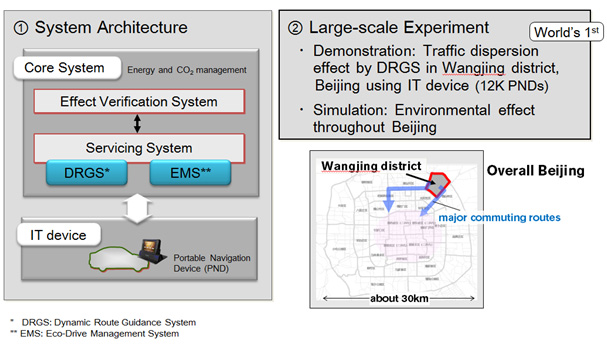Nissan today announced the results from the New Traffic Information System Model Project. The project, which involved 12,000 vehicles in Beijing, demonstrated that Dynamic Route Guidance System (DRGS)1 can help alleviate traffic congestion and reduce fuel consumption.
A simulation based on the project results showed that when 10% of all traffic in Beijing used DRGS, due to reduced traffic congestion, travel speed throughout the city would increase by approximately 10% and both fuel consumption and CO2 emissions would decrease by approximately 10%. This is the world’s first large-scale project to demonstrate and measure traffic dispersion effects with the IT device in a reality setting.
Nissan and the Beijing Municipal Commission of Transport started the test in January 2012, distributing Portable Navigation Devices (PNDs) to 12,000 trial users in the Wangjing district in Beijing. A Memorandum of Understanding (MOU) to conduct the project was signed by Nissan, the National Development and Reform Commission, the Beijing Municipal Development and Reform Commission and the New Energy and Industrial Technology Development Organization (NEDO)2 and PNDs were provided to trial users, allowing them to use DRGS and Eco-Drive Management System (EMS).3
After one year of testing, results have shown that the use of DGRS and EMS contributes to saving energy and reducing emissions. The DRGS helped reduce average travel time by 5.1% and increased fuel economy4 by 7.6% among users. Enabling the drivers to avoid congested roads led to the dispersion of traffic flow, enhancing overall driving speed within the region.
Furthermore, EMS helped increase fuel economy4 by 6.8% by helping users cultivate better driving habits.
The wider adoption of new traffic information systems is said to be an important step in improving urban traffic congestion and air quality in the future. Nissan has taken the initiative in China with advanced IT since the introduction of STAR WINGS with dynamic route guidance in 2008.
Nissan views its work in this area as part of the company’s social responsibility, and hopes that the results of this test will lead to greater acceptance of such technology. Nissan is committed to a six-year environmental plan – Nissan Green Program 2016 – to pursue a balance between resource consumption and the environment to ensure a sustainable society.

